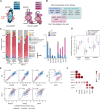Mapping snoRNA-target RNA interactions in an RNA-binding protein-dependent manner with chimeric eCLIP
- PMID: 40001124
- PMCID: PMC11863803
- DOI: 10.1186/s13059-025-03508-7
Mapping snoRNA-target RNA interactions in an RNA-binding protein-dependent manner with chimeric eCLIP
Abstract
Background: Small nucleolar RNAs (snoRNAs) are non-coding RNAs that function in ribosome and spliceosome biogenesis, primarily by guiding modifying enzymes to specific sites on ribosomal RNA (rRNA) and spliceosomal RNA (snRNA). However, many orphan snoRNAs remain uncharacterized, with unidentified or unvalidated targets, and studies on additional snoRNA-associated proteins are limited.
Results: We adapted an enhanced chimeric eCLIP approach to comprehensively profile snoRNA-target RNA interactions using both core and accessory snoRNA-binding proteins as baits. Using core snoRNA-binding proteins, we confirmed most annotated snoRNA-rRNA and snoRNA-snRNA interactions in mouse and human cell lines and called novel, high-confidence interactions for orphan snoRNAs. While some of these interactions result in chemical modification, others may have modification-independent functions. We showed that snoRNA ribonucleoprotein complexes containing certain accessory proteins, like WDR43 and NOLC1, enriched for specific subsets of snoRNA-target RNA interactions with distinct roles in ribosome and spliceosome biogenesis. Notably, we discovered that SNORD89 guides 2'-O-methylation at two neighboring sites in U2 snRNA that fine-tune splice site recognition.
Conclusions: Chimeric eCLIP of snoRNA-associating proteins enables a comprehensive framework for studying snoRNA-target interactions in an RNA-binding protein-dependent manner, revealing novel interactions and regulatory roles in RNA biogenesis.
© 2025. The Author(s).
Conflict of interest statement
Declarations. Ethics approval and consent to participate: Not applicable. Consent for publication: Not applicable. Competing interests: ELVN is co-founder, member of the Board of Directors, on the SAB, equity holder, and paid consultant for Eclipse BioInnovations, on the SAB of RNAConnect, and is inventor of intellectual property owned by University of California San Diego. ELVN’s interests have been reviewed and approved by the Baylor College of Medicine in accordance with its conflict of interest policies. The other authors declare no competing interests.
Figures






Update of
-
Mapping snoRNA-target RNA interactions in an RNA binding protein-dependent manner with chimeric eCLIP.bioRxiv [Preprint]. 2024 Sep 21:2024.09.19.613955. doi: 10.1101/2024.09.19.613955. bioRxiv. 2024. Update in: Genome Biol. 2025 Feb 25;26(1):39. doi: 10.1186/s13059-025-03508-7. PMID: 39345503 Free PMC article. Updated. Preprint.
References
MeSH terms
Substances
Grants and funding
LinkOut - more resources
Full Text Sources

